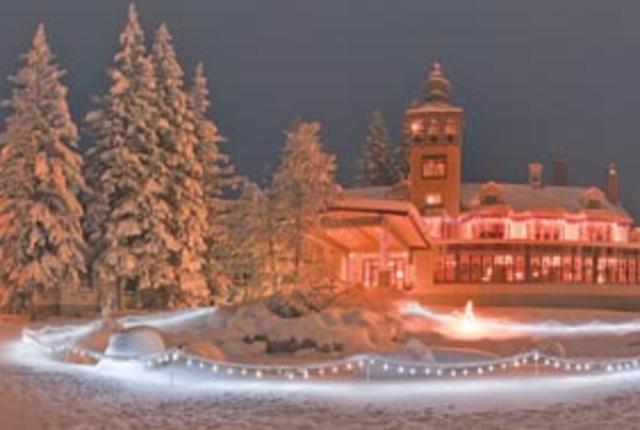Note: This article first appeared in the November, 2011 issue of New Mexico Magazine.
When we need a break from routine, my mother (a sophisticated octogenarian) and I head to Cloudcroft. The town of 900 residents bills itself as “9,000 feet above stress level,” a slogan it earns between its setting amid the million-acre Lincoln National Forest, its quaint village feel without a single stoplight, and its friendly residents.
However, this mountain town 222 miles south of Albuquerque can be capricious. I have trekked there in spring with my hiking boots strapped on, only to find a winter wonderland. And I have packed my skis, eager to hit the slopes, arriving to realize that golf clubs would have served me better. To appreciate the area’s mercurial beauty, I pack a full quiver of gear so I can hike, bike, golf, ski, or ice-skate—and, of course, I always bring an extra bag to hold my shopping treasures.
Our home base and the biggest draw to the area, The Lodge Resort and Spa, offers a plush Victorian stay. This antique jewel is a true destination hotel with a grand copper fireplace in the lobby; a restaurant with stained-glass windows and spectacular mountain views; and cozy rooms with antique furnishings. The décor—rich in leather and velvet—and the refined service conjure an air of Gilded Age gentility that hearkens back to the hotel’s roots. An earlier version of The Lodge served as a summer resort in the late 1800s. It came into being in 1899, when the Alamogordo and Sacramento Railway constructed one of the most spectacular railroads in the West, which climbed 4,280 feet from Alamogordo to here.
Today, I get a deeper look into that history at the Sacramento Mountains Historical Museum and Pioneer Village just east of town. A cluster of 12 buildings, it includes a vintage blacksmith shop, post office, and mission church, along with models and panoramic photos of the “impossible” cloud-climbing railroad. Though the train stopped running in 1947, the town continued to thrive, mostly because of its mild climate, especially in summer.
At the village center, I find one of Cloudcroft’s highlights, the Boardwalk, a cluster of shops and cafés, many with art and crafts made by the shop owners themselves. At Cloudcroft Gallery, Donna Gordon sells her own vibrant pastel landscapes and her husband, David Gordon, shows his delicate horsehair pottery. Down the street, Cricklewood Candle Company offers their homemade bath salts, soaps, and scented candles. And nearby at Red Wall Jewelry, owner Stacey Jones sells unusual handpicked treasures, most notably Australian opals. Here I find an irresisitible vintage Navajo butterfly pendant to take home.
With its mountain setting, Cloudcroft has hundreds of hiking trails, but two of them rank above all others. The 1.3-mile Trestle Trail takes me from a replica of the old Cloudcroft Depot along the abandoned Alamogordo and Sacramento Mountain Railroad grade through old-growth forest to the landmark Mexican Canyon Trestle, a graceful wooden structure 323 feet long and 60 feet high. On previous trips I have biked the 31-mile Rim Trail, one of the nation’s premier single-track romps, with views of White Sands National Monument, 40 miles away.
When the snow arrives, skiers and snowboarders spend their free time at Ski Cloudcroft, three miles east of town. Owner Jeremy Adams grew up working at the business, which opened in 1963, and eventually took over from his father. With 680 vertical feet, 21 runs and three lifts, the resort is more intimate than headliners like Taos Ski Valley and Ski Santa Fe. “It’s a small enough mountain so you can keep track of people,” says Jeremy. In fact, his team, which includes his whole family, watches over many of the local kids while their parents shop in town.
Also during the colder months, locals and visitors convene at the James Sewell Ice Rink at the center of Cloudcroft. One of the southernmost outdoor rinks in the United States, it is completely natural—meaning the ice freezes without electrical refrigeration. The rink rents skates, has a warming hut with a brick fireplace, and is groomed with a classic 1960s Zamboni machine.
I happily return to The Lodge, arriving at the 59-room Victorian hotel, in time to watch the sun set over the pearly ocean of White Sands National Monument. While many spend their days here playing golf at The Lodge’s nine-hole Scottish traditional-style course, today I head to the Spirit of the Mountain Spa, which offers massages, salt glows, and facials. “The Sacramento Mountains are a healing place,” says spa manager Albert Fairweather. “The air, the scent of pines, the wildlife—all help people get back to neutral.”
After my massage, I coast over to meet my mother at The Lodge’s restaurant, Rebecca’s. The elegant dining room has mahogany paneling, views across the Tularosa Basin, and carries the name of the hotel’s resident ghost. In the early 1900s, the blue-eyed chambermaid, Rebecca, was killed by her jealous lover. Today, she’s said to wander the hotel opening and closing doors, turning lights on and off, and igniting blazes in fireplaces. While my mother and I relish a dinner of almond-crusted trout, I feel a breath of air on the back of my neck and wonder if it might be Rebecca. If so, it’s no big deal, I’m relaxed enough to invite her to join us.
Lesley S. King (www.lesleysking.com) day-trips to another little-known place each month.


